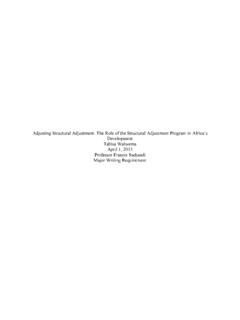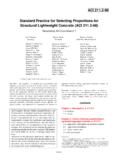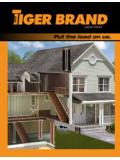Transcription of Reamers - Nomenclature and Definitions
1 Tel: +44 (0) 1484 665321 Fax: +44 (0) 1484 666952E-mail: Road Industrial Estate,Netherton,HuddersfieldHD4 7 DQReamers - Nomenclature and DefinitionsAXIS- The longitudinal centre-line of That portion of the reamer extendingfrom the entering end of the reamer to thecommencement of the That portion of the reamer bywhich it is held and driven.(i) Straight or parallel shank for machine cylindrically ground shank without square.(ii) Parallel hand cylindrical groundshank provided with a square at its extremefor driving the reamer.(iii) Taper shank of recognizedstandard taper for machine That portion of the body which isreduced in diameter below the cuttingedges, pilot or guide The grooves in the body of thereamer to provide cutting edges, to permitthe removal of chips, and to allow cuttingfluid to reach the cutting EDGE- The edge formed by theintersection of the face and the circular landor the surface left by the provision ofprimary That portion of the flute surfaceadjacent to the cutting edge on which thechip impinges as it is cut from the That portion of the fluted body notcut away by the flutes.
2 The surface or thesurfaces included between the cutting edgeand the LAND- The cylindrically groundsurface adjacent to the cutting edge, on theleading edge of the The edge formed by the intersectionof the surface left by the provision ofsecondary clearance and the CLEARANCE- That portion of theland removed to provide clearanceimmediately behind the cutting CLEARANCE- That portion ofthe land removed to provide clearancebehind the primary clearance or circular LEAD- The tapered cutting portion atthe entering end to facilitate the entry of thereamer into the hole. (It is not provided witha circular land).BEVEL LEAD- The angular cutting portion atthe entering end to facilitate the entry of thereamer into the hole. (It is not provided witha circular land).BACK TAPER- The reduction in diameter perinch length of reamer from the entering endtowards the OF CUTTING- (i) Right hand cutting reamer which rotates in a counter-clockwise direction when viewed on the entering end of the reamer.
3 (ii) Left hand cutting reamer which rotates in a clockwise direction when viewed on the entering end of the The maximum cutting diameter of the reamer at the entering end. (See also definition Taper Reamers ).OVERALL LENGTH- The length over the extreme ends of the EDGE LENGTH- The axial length of that portion of the fluted body provided with primary clearances or circular lands and including the taper and bevel LENGTH- The length of that portion of the body which is reduced in diameter below the cutting edges, pilot or guide OF SQUARE- The dimension across the flats of the squared portion at the extreme end of a parallel hand OF SQUARE - The length of the squared portion at the extreme end of a parallel hand LEAD LENGTH- The length measured axially of the taper LEAD LENGTH- The length measured axially of the bevel OF HELIX- The distance measured parallel to the reamer axis between corresponding points on the leading edge of a land in one complete turn of a Reamers - (i) Large end maximum diameter over the tapered cutting edges.
4 (ii) Small end minimum diameter over the tapered cutting HOLE- Defined for size by stating the large end diameter and the taper per foot on diameter or the included angle of the taper, or as a taper ratio, 1 in 96 (included).HELIX ANGLE- The angle between the cutting edge and the reamer LEAD ANGLE- The angle formed by the cutting edges of the taper lead and the reamer LEAD ANGLE- The angle formed by the cutting edges of the bevel lead and the reamer ANGLES- The angles formed by the primary or secondary clearance and the tangent to the periphery of the reamer at the cutting edge or behindthe circular land. They are called primary clearance angle and secondary clearance angle SECTION32 Reamers - Standard SolidsA Reamer is used to finish a pre-drilled hole to a high degree of accuracy and surface finish. It does this byremoving a minimum amount of metal from the sides of the hole whilst being rotated in the same direction asa twist drill at a much slower speed than that used for drilling.
5 However, the spiral flutes of a Reamer are theopposite hand to those of a drill. This pushes swarf away from the cutting edge (unlike a drill where the swarftravels up the flutes) in order to ensure that it does not interfere with the high finish designation of a standard Reamer is therefore - Left hand spiral, Right hand cutting .The 45 degree bevel lead at the point of the Machine Reamer shown is the cutting portion of the tool. The lands merely serve to guide and centralise the reamer in the hole produced by the bevel a point of interest, the accuracy of a reamed hole is indicated by the fact that the total allowable variation(tolerance) on the diameter of a half inch reamer is in. (three ten thousandths of an inch).The amount of metal removed by a reamer is critical - if too little the tool will rub rather than cut. Conversely, a Reamer cannot remove metal from a hole whose diameter is less than the inner diameter of the bevel edge,(the cutting edge).33It is important to appreciate the difference between Machine Reamers and Hand Reamers to avoid confusion when dealing with customerenquiriesMACHINE Reamers have either a Morse Taper or Straight Shank, but are neversquare Reamers always have a square-ended shank for fitting a Tap Wrench.
6 They also have an additional taper lead behind the 45 degreecutting bevel to help the tool centralise itself in the hole if there is any Chucking Reamers have shortflutes and are designed for use inautomatic Machine Tools. They areavailable in various shank and fluteshapes as HAND REAMERMACHINE CHUCKING REAMERSTAPER SHANK MACHINE REAMERSTRAIGHT SHANK MACHINE REAMERB ridge Reamers have a Taper Lead anlgeof 1 in 10 on diameter. They are used forreaming pairs of holes which may beslightly out of alignment when assembled,such as structural steel REAMERHas straight flutes and a taper angle of1 in 48 (imperial) or 1 in 50 (metric).HAND TAPER PIN REAMERTUNGSTEN CARBIDE TIPPED (TCT) AND SOLID CARBIDE MACHINE REAMERSThe grade of Carbide used on both types ofReamer makes them suitable for generalpurpose jobs and reaming difficult materialssuch as Cast Iron and Cupro-Nickels. They can be used at high production ratesto give a high surface finish and a long is advisable to consult the manufacturerfor advice about specific - Re-Grindables and AdjustablesIt is important to appreciate the difference between a Regrindable Machine Reamer and an Adjustable Hand Reamer to avoidmisinterpretation of customer orders, since the former type are sometimes wrongly referred to as adjustable Reamers .
7 Always check whether they are Machine or Hand B33 FERROUS, B47 NON-FERROUS - SIZE RANGE 1/4" to 3-11/32"Adjustable Hand Reamers are versatile tools each capable of reaming a series of odd sized holes over a limited range of adjustment whichgoes from about in ( mm) in the smaller diameters up to around in ( mm) in the larger is easily done with two screwed collars which raise or lower the cutting blades by moving them along tapered seatings. Theyare locked in position when the required diameter is that replacement blades are always supplied and fitted as a matched mm from 10 mm up to 25 mm from 26 mm up to 38 mm from 39 mm up to 50 mmLength of Carbide mm from 10 mm up to 11 mm from 12 mm up to 21 mm from 22 mm up to 30 mm from 31 up up to 50 mm Regrindable Machine Reamers allow a small amount ofadjustment to compensate for wear. The body of the reamercan be expanded by turning a centre screw as detailed adjusting screw should never be backed off and anydownsizing can only be achieved by amount of allowable expansion for different reamerdiameters is shown in the of AdjustmentThe appropriate size of socket screw key (or wrench) is inserted in the adjusting screw socket andturned in a clockwise direction until sufficient body expansion is achieved for economical that the maximum possible size expansion is stated in the table on the check is by any normal method such as micrometer, vernier or land width and relief angle for the bevel cutting lead are as normal for a solid reamer ofequivalent size.
8 Back taper from the bevel lead should be between and in on diameterper inch of flute guide lines stated above apply equally to High Speed Steel and tungsten Carbide Tipped reamerswith the necessary alteration of relief clearance angles for the TCT is essential that you should - only regrind with the adjusting screw tightly SHANK REGRINDABLE MACHINE Reamers ( AND )ADJUSTABLE HAND REAMERADJUSTING NUTRINGFRONT ADJUSTING NUTTAPERED SLOTHSS BLADESIZE ADJUSTMENT<<< DECREASE - INCREASE >>>SCREW ON EXTENSION PILOTRUNNING BUSH35 Reamers - Adjustable FloatingA F ReamersAdjustableInbuilt micrometer adjustment giving infinite sizing within the Reamer range and allowing instant settingto finished size on floating blades(HSS/TCT) minimise any misalignment caused by worn machine spindles and poorclamping set RangeThe range of Taylor & Jones A F Reamers comprising 19different sizes covering bores from to (1/2 to 4 ) includes two types, the SS Reamer for sizesfrom to 19mm (1/2 to 3/4 ) and the S typefrom 19mm to (3/4 to 4 ).
9 The SS type Reamer has HSS or TCT blades and issuitable for reaming thro S type Reamer also has HSS or TCT blades suitablefor reaming thro bores but can be fitted with SL type L-shaped blades for reaming blind or stepped and AdjustmentSet the blades to a size approximately ( ) below the required size of bore, using amicrometer. Make a short cut and measure the bore size. Adjust the blade setting using the adjusting dialring, noting that the direction of rotation is given looking from the shank adjusting dial ring is graduated to give an overall blade movement of ( ) for oneincrement of increase the blade setting1) Rotate the adjusting dial ring anti-clockwise through the number of divisions necessary to make therequired ) Rotate the adjusting lock ring anti-clockwise until the two rings are firmly locked decrease the blade setting1) Rotate the adjusting lock ring clockwise to free the adjusting dial ) Rotate the two adjusting rings in a clockwise direction until the adjusting dial ring has moved throughthe number of divisions necessary to make the required ) Rotate the adjusting lock ring anti-clockwise until the two rings are firmly locked Type BladeSL Type Blade36A F Reamers - Component PartsSection through S Type HSS ReamerBlade RemovalSS Type1) Remove the end )
10 Cause the plunger to protrude from the body by rotation of the adjusting rings. Continue the rotationuntil the float limiting pin is clear of the ) Press out the float limiting pin and withdraw the blades, complete with rhomboidal key, from ) Separate the blades and remove the rhomboidal and SL Types1) Rotate the adjusting lock ring clockwise and the adjusting dial ring anti-clockwise, looking from the shankend, until there is sufficient space between the two to remove the transverse ) Remove the transverse ) Remove the end ) Withdraw the blade/plunger ) Press out the float limiting pin and withdraw the blades, complete with rhomboidal key, from ) Separate the blades and remove the rhomboidal reassemble both types of reamer the procedure used to dismantle is exactly Reaming Guidelines apply for stock removal and rates of speed and feed. The optimum operatingcriteria will be found by adjustment to guide valves when taking into account variations in material, machineset up and finish requirements.





